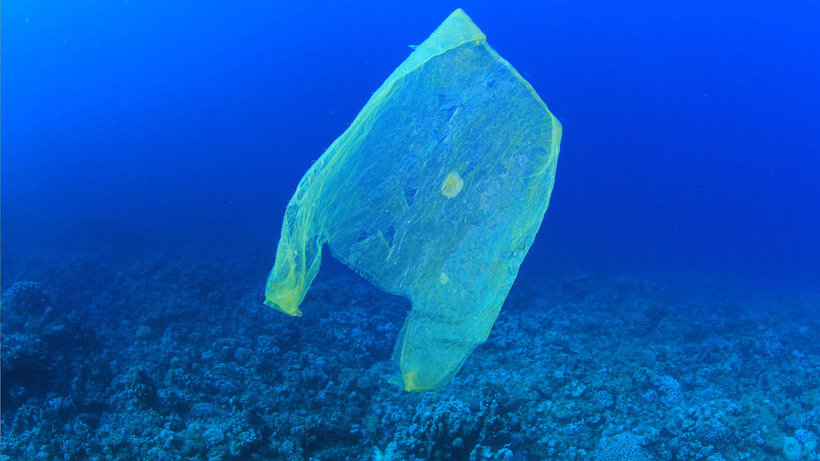
In June 2020, the German cabinet introduced a regulation banning certain single-use products made of plastic; the European Union had already introduced a similar regulation in May 2019. In future, the sale of products such as throwaway plastic cutlery, plates, straws and cotton buds will be prohibited.
At first blush, the ban looks like a great environmental success: after all, reports on microplastic pollution and images of plastic bags washed up on beaches are all over the news. But at second glance, it becomes clear that the ban merely creates the illusion of cleaning up the environment and the world’s oceans.
Many so-called “eco-friendly” alternatives have a worse environmental footprint and contain questionable additives. The debate about plastic pollution is often one-sided. This matters, because not all plastics are the same, and not all synthetic materials are harmful to the environment.
Plastic is a chemical innovation dating back to the 1950s. At the time, a breakthrough in polymer research enabled plastics to be mass-produced at a low cost. Since then, about 8.3 billion tonnes of plastic have been produced worldwide. The advantages are obvious: plastics are cheap to produce, weigh less than metal and glass products, are usually durable and highly versatile. Few materials are more suitable for recycling.
However, only 16% of the world’s plastic is recycled. The vast majority of plastics remain in the environment as waste, collected in landfills at best. Plastic is everywhere. And it increasingly ends up where it doesn’t belong, for example as microplastics in snow or in the stomachs of fishes.
Developing countries are the main culprits when it comes to the oceans’ plastic pollution problem: just ten Asian and African rivers are responsible for about 90 percent of the plastic that ends up in the sea.
Because of globalisation, however, everything is connected with everything else, so countermeasures also have to be taken in Europe, both at the policy level and by businesses and individuals. If you really want to do something for the environment, exercise your consumer power and avoid falling for unsustainable offers that do nothing but “greenwash” your conscience.
The gold standard we should aspire to is to view plastic not as a throwaway product, but as a valuable, depletable resource.
In our daily lives, we should aim to use plastic as many times and for as long as possible, returning it to the raw material cycle once we’ve finished using it. The process begins when we separate our waste, because only cleanly separated waste can be properly recycled.
As consumers, we should also try to avoid using plastic whenever possible. It isn’t possible to eliminate our use of plastic entirely, because everyday objects such as smartphones and light, water-repellent outdoor jackets depend on it, to name but two examples.
Consumers are already making less use of throwaway plastic products. Instead, they are bringing their own thermal mugs to cafés and choosing glass bottles and paper bags over plastic.
There are many situations where we can get by without plastic, but we should keep in mind that not everything that isn’t made of plastic is good, and not everything marked as “eco-friendly” is kind to the environment. Paper, for example, doesn’t have a particularly good environmental track record.
Making paper takes a lot of water and energy, and it ha
s functional disadvantages such as being prone to tearing and not being waterproof. To make paper straws last longer, they are sometimes given a special coating, but the coating means they can’t be recycled afterwards.
Even bamboo products are often overrated. Stiftung Warentest, a German consumer watchdog, has cautioned the public about the use of bamboo cups because they can contain harmful substances.
Essentially, they are plastic cups that use bamboo fibres as a filler. Glass bottles, too, are not always the best solution because producing them takes a lot of energy. They are also heavy, meaning that transporting them from one place to another gives them a large CO2 footprint. Glass bottles are only sustainable when they are reused multiple times and preferably made and used locally.
Often, the best replacement for plastic is in fact plastic, such as multiple-use plastics made of polypropylene, which can be reused and recycled often.
A change in mindset that gives greater prominence to the recycling economy is vitally important. Plastics do not belong in the environment. One of their greatest assets – their extreme durability – becomes a liability when they aren’t disposed of correctly. Plastic degrades very slowly, and the tiny particles generated as it gets abraded end up in in nature as microplastics.
In addition, plastics often contain harmful additives such as plasticisers and flame retardants. As much as 35 percent of all microplastics are produced through the abrasion of synthetic fabrics during washing. In China, for example, 72,000 tonnes of microfibres per year end up in the environment in this way.
In contrast, Germany is one of the “good guys” when it comes to dealing with plastics. Almost 100 percent of the country’s plastic waste is either incinerated or recycled.
Furthermore, European chemicals companies and plastics manufacturers are hard at work on pilot projects in the area of chemical recycling. Here, the idea is to apply thermal pyrolysis to plastic waste to break it apart into its constituents, which can then be used as raw materials that get fed back into base chemical manufacturing plants.
The use of biologically degradable plastics in packaging remains a further area of concern. Degradable plastics are ill-suited to protecting foodstuffs against environmental influences.
In addition, it would require even more diligent waste separation because not every recycled plastic can be used for food packaging – think of plastic previously used as detergent packaging.
Clearly, more innovation is needed from the base chemistry and plastics industries, but as their reputation and future growth depend on their progress, they have an incentive to prioritise the research. The “Alliance to End Plastic Waste”, an initiative launched by about 30 multinationals in January, is a good start.
Another important element in the battle against plastic waste in the oceans could be an EU-wide prohibition on dumping residential waste in landfills. In southern Europe especially, not all households are connected to sewage treatment plants. Plastic objects are flushed into the sea with untreated water.
Internationally, there is a lack of a sustainable strategy for supporting emerging and developing countries in introducing closed waste recycling systems.
Continue exploring:
Climate-Wise: Why Environment Is Not a Side Issue
Self-Reflecting Helps Citizens Become Better People [Interview with Francesca Grippa]























